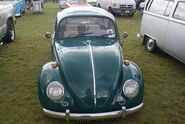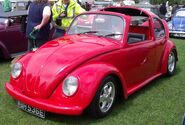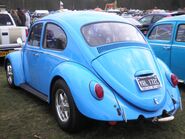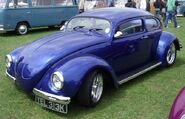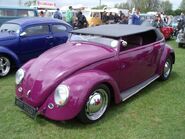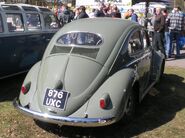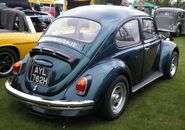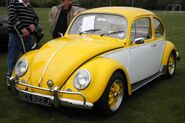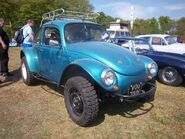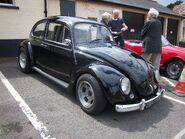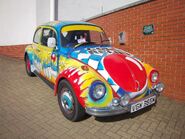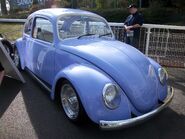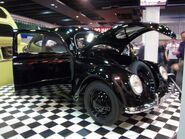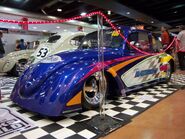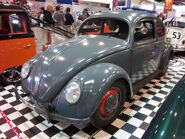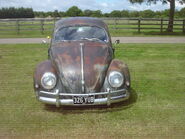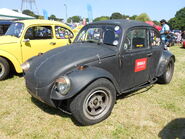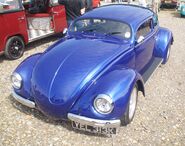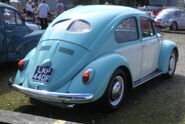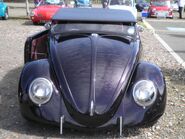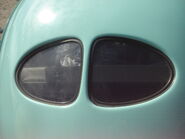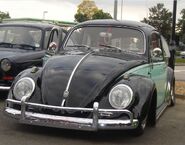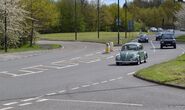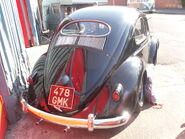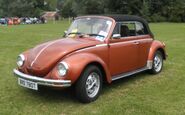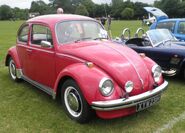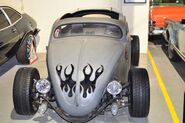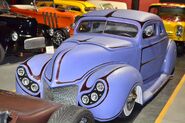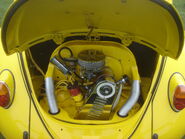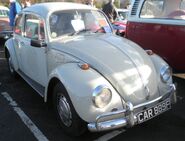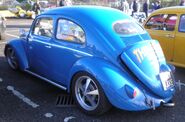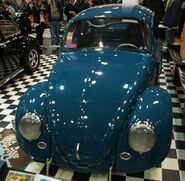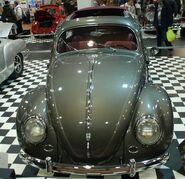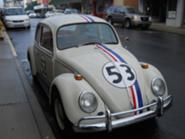
Herbie, a 1966 Volkswagen Beetle
The Volkswagen Beetle, officially called the Volkswagen Type 1 (or informally the Volkswagen Bug), is an economy car produced by the German auto maker Volkswagen (VW) from 1938 until 2003. With over 21 million manufactured in an air-cooled, rear-engined, rear-wheel drive configuration, the Beetle is the longest-running and most-manufactured car of a single design platform anywhere in the world.
Overview[]
Although designed in the 1930s, the Beetle was only produced in significant numbers from 1945 onwards, when the model was internally designated the Volkswagen Type 1, and marketed simply as the "Volkswagen". Later models were designated VW 1200, 1300, 1500, 1302 or 1303, the former three indicating engine displacement and the latter two being derived from the type number and not indicative of engine capacity. The model became widely known in its home country as the Käfer (German for "beetle") and was later marketed as such in Germany, and as the Volkswagen Beetle in other countries.
In the 1950s, the Beetle was more comfortable and powerful than most European small cars,[citation needed] having been designed for sustained high speed on the Autobahn. It remained a top seller in the U.S., owing much of its success to high build-quality and innovative advertising,[citation needed] ultimately giving rise to variants, including the Volkswagen Karmann Ghia and the Volkswagen Type 2 van. Along with cars including the Morris Minor, Fiat 500, Renault 4CV and Dauphine, and Citroën 2CV, the Beetle pioneered the modern continental economy car and later served as the benchmark for the initial two generations of North American compact cars, including the Chevrolet Corvair and Ford Falcon, as well as later subcompact cars such as the Chevrolet Vega and Ford Pinto.
The Beetle had marked a significant trend led by Volkswagen, Fiat, and Renault whereby the rear-engine, rear-wheel drive layout had increased from 2.6 percent of continental Western Europe's car production in 1946 to 26.6 percent in 1956. The 1948 Citroën 2CV and other European models marked a later trend to front-wheel drive in the European small car market, a trend that would come to dominate that market. In 1974, Volkswagen's own front-wheel drive Golf model succeeded the Beetle. In 1994, Volkswagen unveiled the Concept One, a "retro"-themed concept car with a resemblance to the original Beetle, and in 1998 introduced the "New Beetle", built on the Golf platform with styling recalling the original Type 1. In a 1999 international poll for the world's most influential car of the 20th century, the Type 1 came fourth, after theFord Model T, the Mini, and the Citroën DS.
Design overview[]
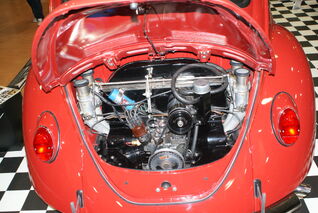
Volkswagen Beetle engine
The Beetle featured a rear-located, rear-wheel drive, air-cooled four-cylinder, boxer engine in a two-door bodywork featuring a flat front windscreen, accommodating four passengers and providing luggage storage under the front bonnet and behind the rear seat – and offering a Cx or coefficient of drag of 0.41. The bodywork attached with eighteen bolts to its nearly flat chassis which featured a central structural tunnel. Front and rear suspension featured torsion bars along with front and rear stabilizer bars – providing independent suspensions at all wheels. Certain initial features were subsequently revised, including mechanical drum brakes, split-window rear windows, mechanical direction-indicators and the non-synchronized gearbox. Other features, including its distinctive overall shape, endured.
Its engine, transmission, and cylinder heads were constructed of light alloy. An engine oil cooler (located in the engine fan's shroud) ensured optimal engine operating temperature and long engine life, optimized by a thermostat that bypassed the oil cooler when the engine was cold. Later models of the carburetor featured an automatic choke. Engine intake air passed through a metallic filter, while heavier particles were captured by an oil bath. After 1960, steering featured a hydraulic damper that absorbed steering irregularities. Indicative of the car's simple, no-nonsense design, the interior featured painted metal surfaces, a metal dash consolidating instruments in a single, circular binnacle, adjustable front seats, a fold-down rear seat, optional swing-out rear windows, front windows with pivoting vent windows, heating via air-to-air exchange manifolds operating off the engine's heat, and a windshield washer system that eschewed the complexity and cost of an additional electric pump and instead received its pressurization from the car's spare tire (located in the front luggage compartment) which was accordingly overinflated to accommodate the washer function.
While the overall appearance of the Beetle changed little over its life span, it received over 78,000 incremental changes during its production
History[]
"The People's Car"[]
In 1931, Ferdinand Porsche developed the Porsche Type 12, or "Auto für Jedermann" (car for everybody) for Zündapp. Porsche already preferred the flat-four engine, and selected a swing axle rear suspension (invented by Edmund Rumpler), while Zündapp insisted on a water-cooled five-cylinder radial engine. In 1932, three prototypes were running. All of those cars were lost during World War II, the last in a bombing raid in Stuttgart in 1945.
The Zündapp prototypes were followed by the Porsche Type 32, designed in 1933 for NSU Motorenwerke AG, another motorcycle company. The Type 32 was similar in design to the Type 12, but had a flat-four engine. NSU's exit from car manufacturing resulted in the Type 32 being abandoned at the prototype stage.
In 1933, Adolf Hitler gave the order to Ferdinand Porsche to develop a Volkswagen (literally, "people's car" in German, pronounced [ˈfɔlksvaːɡən]). The epithet Volks- literally, "people's-" had been previously applied to other Nazi sponsored consumer goods such as the Volksempfänger ("people's radio"). Hitler required a basic vehicle capable of transporting two adults and three children at 100 km/h (62 mph). The "People's Car" would be available to citizens of the Third Reich through a savings scheme, or Sparkarte (savings booklet), at 990 Reichsmark, about the price of a small motorcycle (an average income being around 32RM a week). Historian Paul Schilperoord argued in his 2011 biography of Josef Ganz that Hitler stole the idea for the Volkswagen Beetle from Ganz's "May Bug," which he saw in 1933 at an auto show.
Development[]

Volkswagen Beetle cut-away
Initially designated the Porsche Type 60 by Ferdinand Porsche, the design team included Erwin Komenda and Karl Rabe. In October 1935 the first two Type 60 prototypes, known as the V1 and V2 (V for Versuchswagen, or "test car"), were ready. In 1936, testing of three further V3 prototypes, built in Porsche's Stuttgart shop, began. A batch of thirty W30 development models, produced for Porsche by Daimler-Benz, underwent 1,800,000 mi (2,900,000 km) of further testing in 1937. All cars already had the distinctive round shape and the air-cooled, rear-mounted engine. Included in this batch was a rollback soft top called the Cabrio Limousine. A further batch of 44 VW38 pre-production cars produced in 1938 introduced split rear windows; both the split window and the dash were retained on production Type 1s until 1953. The VW38 cars were followed by another batch of 50 VW39 cars, completed in July 1939.
The car was designed to be as simple as possible mechanically, so that there was less to go wrong; the aircooled 25 hp (19 kW) 995 cc (60.7 cu in)[20] motors proved especially effective in actions of the German Afrika Korps in Africa's desert heat. This was due to the built-in oil cooler and the superior performance of the flat-four engine configuration. The suspension design used compact torsion bars instead of coil or leaf springs. The Beetle is nearly airtight and will float for a few minutes on water.
The Volkswagen was officially named the KdF-Wagen by Hitler when the project was officially announced in 1938. The name refers to Kraft durch Freude ('Strength Through Joy'), the official leisure organization of the Third Reich. The model village of Stadt des KdF-Wagens was created near Fallersleben in Lower Saxony in 1938 for the benefit of the workers at the newly built factory. After World War II, it was known as the Volkswagen Type 1, but became more commonly known as the Beetle.
Influence of Tatra[]
The Austrian car designer Hans Ledwinka was a contemporary of Porsche working at the Czechoslovakian company Tatra. In 1931, Tatra built the V570 prototype, which had an air-cooled flat-twin engine engine mounted at the rear.[9] This was followed in 1933 by a second V570 prototype with a streamlined body similar to that of the Porsche Type 32. The rear-engine, rear-wheel drive layout was a challenge for effective air cooling, and during development of the much larger V8 engined Tatra T77 in 1933 Tatra registered numerous patents related to air flow into the rear engine compartment. The use of Tatra's patented air cooling designs later became one of ten issues for which Tatra filed suit against VW.
Both Hitler and Porsche were influenced by the Tatras. Hitler was a keen automotive enthusiast, and had ridden in Tatras during political tours of Czechoslovakia. He had also dined numerous times with Ledwinka. After one of these dinners Hitler remarked to Porsche, "This is the car for my roads".From 1933 onwards, Ledwinka and Porsche met regularly to discuss their designs, and Porsche admitted "Well, sometimes I looked over his shoulder and sometimes he looked over mine" while designing the Volkswagen. The Tatra T97 of 1936 had a 1,749 cc, rear-located, rear-wheel drive, air-cooled four-cylinder boxer engine. It cost 5,600 RM and accommodated five passengers in its extensively streamlined four-door body, which provided luggage storage under the front bonnet and behind the rear seats. It also featured a similar central structural tunnel found in the Beetle.
Just before the start of the Second World War, Tatra had ten legal claims filed against VW for infringement of patents. Although Ferdinand Porsche was about to pay a settlement to Tatra, he was stopped by Hitler who said he would "solve his problem". Tatra launched a lawsuit, but this was stopped when Germany invaded Czechoslovakia in 1938, resulting in the Tatra factory coming under Nazi administration in October 1938. The T97, along with the T57, were ordered by Hitler to be removed from the Tatra display at the 1939 Berlin Autosalon[23] and Tatra was later directed to concentrate on heavy trucks and diesel engines, with all car models, except for the V8-engined Tatra T87, being discontinued.[22] The matter was re-opened after World War II and in 1961 Volkswagen paid Ringhoffer-Tatra 3,000,000 Deutsche Marks in an out of court settlement.
Wartime production[]
The factory had only produced a handful of cars by the start of the war in 1939; the first volume-produced versions of the car's chassis were military vehicles, the Type 82 Kübelwagen (approximately 52,000 built) and the amphibious Type 166 Schwimmwagen (about 14,000 built).
A handful of Beetles were produced specifically for civilians, primarily for the Nazi elite, in the years 1940 to 1945, but production figures were small. Because of gasoline shortages, a few wartime "Holzbrenner" Beetles were fueled by wood pyrolysis gas producers under the hood. In addition to the Kübelwagen, Schwimmwagen, and a handful of others, the factory managed another wartime vehicle: the Kommandeurwagen; a Beetle body mounted on the Kübelwagen chassis. 669 Kommandeurwagens were produced up to 1945, when all production was halted because of heavy damage to the factory by Allied air raids. Much of the essential equipment had already been moved to underground bunkers for protection, which let production resume quickly after hostilities ended.
Post-war production and boom[]
In occupied Germany, the Allies followed the Morgenthau plan to remove all German war potential by complete or partial pastoralization. As part of this, in the Industrial plans for Germany, the rules for which industry Germany was to be allowed to retain were set out. German car production was set at a maximum of 10% of the 1936 car production numbers.
Mass production of civilian VW cars did not start until post-war occupation. The Volkswagen factory was handed over by the Americans to British control in 1945; it was to be dismantled and shipped to Britain. Thankfully for Volkswagen, no British car manufacturer was interested in the factory; "the vehicle does not meet the fundamental technical requirement of a motor-car ... it is quite unattractive to the average buyer ... To build the car commercially would be a completely uneconomic enterprise." The factory survived by producing cars for the British Army instead. Allied dismantling policy changed in late 1946 to mid 1947, although heavy industry continued to be dismantled until 1951. In March 1947, Herbert Hoover helped change policy by stating
"There is the illusion that the New Germany left after the annexations can be reduced to a 'pastoral state'. It cannot be done unless we exterminate or move 25,000,000 people out of it."
The re-opening of the factory is largely accredited to British Army officer Major Ivan Hirst (1916–2000). Hirst was ordered to take control of the heavily bombed factory, which the Americans had captured. His first task was to remove an unexploded bomb that had fallen through the roof and lodged itself between some pieces of irreplaceable production equipment; if the bomb had exploded, the Beetle's fate would have been sealed. Hirst persuaded the British military to order 20,000 of the cars, and by March 1946 the factory was producing 1,000 cars a month, which Hirst said "was the limit set by the availability of materials". During this period, the car reverted to its original name of Volkswagen and the town was renamed Wolfsburg. The first 1,785 Type 1s were made in 1945.
Following the British Army-led restart of production, former Opel manager (and formerly a detractor of the Volkswagen) Heinz Nordhoff was appointed director of the Volkswagen factory. Under Nordhoff, production increased dramatically over the following decade, with the one-millionth car coming off the assembly line by 1955. During this post-war period, the Beetle had superior performance in its category with a top speed of 115 km/h (71 mph) and 0–100 km/h (0–60 mph) in 27.5 seconds with fuel consumption of 6.7 l/100 km (36 mpg) for the standard 25 kW (34 hp) engine. This was far superior to the Citroën 2CV which was aimed at a low speed/poor road rural peasant market and Morris Minor that was designed for a market that had no motorways / freeways, and even competitive with more advanced and small wheeled city cars like the Austin Mini. In Small Wonder, Walter Henry Nelson wrote: "The engine fires up immediately without a choke. It has tolerable road-handling and is economical to maintain. Although a small car, the engine has great elasticity and gave the feeling of better output than its small nominal size." Opinion in the United States was not flattering, however, perhaps because of the characteristic differences between the American and European car markets. Henry Ford II once described the car as "a little box."[citation needed] The Ford company was offered the entire VW works after the war for free. Ford's right-hand man Ernest Breech was asked what he thought, and told Henry II, "What we're being offered here, Mr. Ford, isn't worth a damn!"[citation needed] During the 1950s, the car was modified progressively: the obvious visual changes mostly concerned the rear windows.[30] In March 1953, the small oval two-piece rear window was replaced by a slightly larger single-piece window. More dramatically, in August 1957 a much larger full width rear window replaced the oval one. 1964 saw the introduction of a widened cover for the light over the rear licence plate. Towards the end of 1964, the height of the side windows and windscreen grew slightly, giving the cabin a less pinched look: this coincided with the introduction of a very slightly curved ("panoramic") windscreen, though the curve was barely noticeable. The same body appeared during 1966, with a 1,300 cc engine in place of the 1,200 cc engine: it was only in the 1973 model Super Beetle that the Beetle acquired an obviously curved windscreen. The flat windscreen remained on the standard Beetle.
There were also changes under the bonnet. In 1954, Volkswagen added 2 mm to the cylinder bore, increasing the displacement from 1,131 cc to 1,192 cc.[31] This coincided with upgrades to various key components including a redesign of the crankshaft. This increased power from 33 bhp to a claimed 40 bhp and improved the engine's free revving abilities without compromising torque at lower engine speeds. At the same time, compression ratios were progressively raised as, little by little, the octane ratings of available fuel was raised in major markets during the 1950s and 1960s.
There were other, less-numerous models, as well. The Hebmüller cabriolet (officially Type 14A), a sporty two-seater, was built between 1949 and 1953; it numbered 696. The Type 18A, a fixed-top cabriolet, was produced by Austro-Tatra as a police and fire unit; 203 were assembled between January 1950 and March 1953.
Beetle sales boomed in the 1960s, thanks to clever advertising campaigns, and the Beetle's reputation for reliability and sturdiness. On 17 February 1972, when Beetle No. 15,007,034 was produced, Beetle production surpassed that of the previous record holder, the Ford Model T. By 1973, total production was over 16 million, and by 23 June 1992, over 21 million had been produced.
Diesel[]
In 1951, Volkswagen prototyped a 1.3 L diesel engine. Volkswagen made only 2 air-cooled boxer diesel engines that were not turbocharged, and installed one engine in a Type 1 and another in a Type 2. The diesel Beetle was time tested on the Nürburgring and achieved 0–100 km/h (0–62 mph) in 60 seconds.
Introduction to Ireland[]
Main article: History of Volkswagen in Ireland Volkswagen began its involvement in Ireland when in 1949, Motor Distributors Limited, founded by Stephen O'Flaherty secured the franchise for the country at that year’s Paris Motor Show. In 1950, Volkswagen Beetles started arriving into Dublin packed in crates in what was termed "completely knocked down" (CKD) form ready to be assembled. The vehicles were assembled in a former tram depot at 162 Shelbourne Road in Ballsbridge. This is now the premises for Ballsbridge Motors who are still a Volkswagen dealer. The first Volkswagen ever assembled outside Germany was built here. This vehicle is now on display at the Volkswagen Museum in Wolfsburg.
Introduction to the UK[]
The first Volkswagen Beetle dealer in the UK was J.Gilder & Co. Ltd. in Sheffield, which began selling Volkswagens in 1953. Jack Gilder had been fascinated by both the design and engineering of the Beetle when he came across one in Belgium during the war. He applied for the franchise as soon as the opportunity presented itself and became Volkswagen's representative in the North of England.
VW Beetle 1953–1957[]
During this period, the rear window of the VW Beetle evolved from a divided or "split" oval, to a singular oval. Steel used for the bodywork was at its best quality, and the Wolfsburg emblem at the tip of the front of the bonnet was a complex fabrication (subsequent models deleted the emblem). The rear 'W' decklid was hand-fabricated. The front wing had a particular 'flare out'.
VW Beetle 1967[]
The Beetle underwent significant changes for the 1967 model. While the car appeared similar to earlier models, much of the drivetrain was noticeably upgraded. Some of the changes included a larger-displacement engine for the second year in a row. Horsepower had been increased to 37 kW (50 hp) the previous year, and for 1967 it was increased even more, to 40 kW (54 hp). On U.S. models, the output of the electrical generator was increased from 180 to 360 watts, and upgraded from a 6-volt to a 12-volt system. The clutch disc also increased in size, and changes were made to the flywheel, braking system, and rear axle. New standard equipment included two-speed windscreen wipers, reversing lights, a driver's armrest on the door, locking buttons on the doors, and a passenger's side exterior mirror. The 1967 model weighed 840 kg (1,900 lb), which was a typical weight for a European car at this time. That same year, in accord with the newly enacted U.S. Federal Motor Vehicle Safety Standard 108, the clear glass headlamp covers were deleted; the headlamps were brought forward to the leading edge of the front fenders, and the sealed-beam units were exposed and surrounded by chrome bezels. For the 1968 model year, Beetles sold outside North America received the same more upright and forward headlamp placement, but with replaceable-bulb headlamps compliant with ECE regulations rather than the U.S. sealed beams.
The Super Beetle and final evolution[]
In 1971, alongside continued production of the "standard" Beetle, a Type 1 variant which featured MacPherson strut front suspension and a redesigned front end. Officially known (and marketed in Europe) as the VW 1302 from 1971 to 1972, and VW 1303 from 1973 onwards, but commonly called Super Beetle, the new stretched nose design replaced the dual parallel torsion bar beams which had compromised trunk space and relocated the spare tire from a near vertical to a low horizontal position. The redesign resulted in a tighter turning radius despite a 20 mm (0.79 in) longer wheelbase, and a doubling of the front compartment's cargo volume. As with previous models, air pressure from the spare tire pressurized the windshield washer canister, in lieu of an electric pump.
1972 Super Beetles had an 11% larger rear window (4 mm (0.16 in) taller), larger front brakes, four rows of vents (versus two rows previously) on the engine deck lid, tail lights incorporating reverse lights, a four-spoke energy-absorbing steering wheel and steering column, and an engine compartment socket for a proprietary VW Diagnosis system.
In 1973, the VW 1303 introduced a curved windscreen, pushed forward and away from the passengers, allowing a redesigned, padded dashboard to replace the pre-1973 vertical dash. A two-speed heater fan, higher rear mudguards, and larger tail lights were added. The changes to the heater/windshield wiper housing and curved windshield resulted in slight redesign of the front hood, making the 1971 and 1972 Super Beetle hoods unique.
For 1974, the previous flat steel bumper mounting brackets were replaced with tubular "self restoring energy absorbing" attachments, effectively shock absorbers for the bumpers, on North American market Beetles. These cars also got stronger "5 mph" bumpers that added an inch to the length of the car. The steering knuckle and consequently the lower attachment point of the strut was redesigned to improve handling and stability in the event of a tire blowout. This means struts from pre-1974 Super Beetles are not interchangeable with 1974–79s.
1975 models featured Air Flow Control (AFC) Fuel Injection on U.S., Canadian, and Japanese Beetles, a derivative of the more complex Bosch fuel injection system used in the Volkswagen Type III – and equivalent to Bosch L-jetronic. The fuel-injected engine also received a new muffler and the option of an upstream catalytic converter required on some models (e.g. California), necessitating a bulge in the rear apron sheet metal directly under the rear bumper, and replacing the distinctive dual "pea shooter" pipes with a single offset tailpipe – making fuel-injected models identifiable at a glance. Other changes were rack and pinion steering replacing the traditional worm and roller gearbox on Super Beetles, and a larger license plate lamp housing below the engine lid. The front turn indicators were moved from the top of the fenders into the bumper bars on European models. In 1976, the optional "Auto-stick" transmission and the Super Beetle sedan were discontinued, with VW continuing to market the standard sedan and VW 1303 convertible. 1976-on convertibles received no significant engineering changes, only a few cosmetic touches and new paint options, including the "Champagne Edition" models (white on white was one example) to the final 1979 "Epilogue Edition" black on black, in salute to the first Beetles produced in the 1930s. 1977 model sedans received front seats with separate head restraints.
Beetle cabriolet[]
VW 1300 (1972) with an aftermarket rain shield over the engine hatch air vents. The Beetle Cabriolet began production in 1949 by Karmann in Osnabrück. It was in 1948 when Wilhelm Karmann bought a VW Beetle sedan and converted it into a four-seated convertible. After successfully presenting it at VW in Wolfsburg, production started in 1949. After a number of stylistic and technical alterations made to the Karmann cabriolet,[40] (corresponding to the many changes VW made to the Beetle throughout its history), the last of 331,847 cabriolets came off the conveyor belt on 10 January 1980.
Decline[]
Though extremely successful in the 1960s, the Beetle was faced with stiff competition from more modern designs. The Japanese had refined rear-wheel-drive, water-cooled, front-engine small cars to where they sold well in the North American market, and Americans introduced their own similarly sized rear-wheel-drive Chevrolet Vega, Ford Pinto and AMC Gremlin in the 1970s. The superminis in Europe adopted even more efficient transverse-engine front-wheel-drive layouts, and sales began dropping off in the mid 1970s. There had been several unsuccessful attempts to replace or supplement the Beetle in the VW product line throughout the 1960s; the Type 3, Type 4, and the NSU-based K70 were all less successful than the Beetle, though aimed at more upscale markets for which VW lacked credibility. The over-reliance on the Beetle meant that Volkswagen was in financial crisis by 1974. It needed German government funding to produce the Beetle's replacement. Only when production lines at Wolfsburg switched to the new watercooled, front-engined, front-wheel drive Golf designed by Giorgetto Giugiaro in 1974, (sold in North America as the "Rabbit") did Volkswagen produce a car as successful as the Beetle. The Golf would be periodically redesigned over its lifetime – entering its sixth generation in 2008 – with only a few components carried over between generations, while the Beetle used only minor refinements of its original design.
The Golf did not kill Beetle production, which continued in smaller numbers at other German factories until 19 January 1978, when mainstream production shifted to Brazil and Mexico, markets where low operating cost was more important. It is important to note that the Beetle Cabriolet was still produced for the North American and European markets in Germany until 10 January 1980. The last Beetle was produced in Puebla, Mexico, in July 2003. The final batch of 3,000 Beetles were sold as 2004 models and badged as the Última Edición, with whitewall tires, a host of previously discontinued chrome trim, and the choice of two special paint colors taken from the New Beetle. Production in Brazil ended in 1986, then started again in 1993 and continued until 1996. Volkswagen sold Beetle sedans in the United States until August 1977 (the Beetle convertible/Cabriolet was sold until January 1980) and in Europe until 1985, with private companies continuing to import cars produced in Mexico after 1985. The Beetle outlasted most other cars which had copied the rear air-cooled engine layout such as those by Subaru, Fiat, Renault and General Motors. Porsche's sport coupes which were originally based on Volkswagen parts and platforms continue to use the classic rear engine layout (which later became water-cooled) in the Porsche 911 series, which remains competitive in the first decade of the 21st century.
In Film[]
- The Volkswagen Beetle is perhaps known very well because of its role as the personified VW Beetle racecar named Herbie in Disney's 1969 feature film The Love Bug. Herbie has appeared in 5 films, a TV show, and a remake ABC Family TV movie. Consult Star Cars Wikipedia for a more detailed account of Herbie.
On Television[]
In the original incarnation of the Transformers action cartoon series, Autobot Bumblebee transformed into a Beetle.

